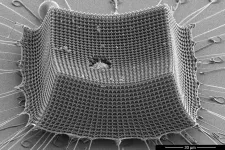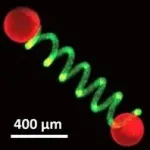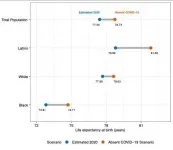(Press-News.org) LA JOLLA, CA--New research led by scientists at La Jolla Institute for Immunology (LJI) and the University of Liverpool may explain why many cancer patients do not respond to anti-PD-1 cancer immunotherapies--also called checkpoint inhibitors.
The team reports that these patients may have tumors with high numbers of T follicular regulatory (Tfr) cells.
In a healthy person, Tfr cells do the important job of stopping haywire T cells and autoantibodies from attacking the body's own tissues. But in a cancer patient, Tfr cells dramatically dial back the body's ability to kill cancer cells.
Anti-PD-1 cancer immunotherapies boost the body's cancer-fighting T cells, but in many patients, suppressive Tfr cells bring that progress to a grinding halt.
With this new understanding of what's going on inside tumors, the researchers believe that first treating these patients with drugs to deplete Tfr cells may prime the body to respond to subsequent anti-PD-1 therapies and increase overall survival.
"Our data begin to point the way towards how we might be able to improve cancer treatments," says study co-leader Christian H. Ottensmeier, M.D., Ph.D., FRCP, a professor at the University of Liverpool and adjunct professor at LJI.
The study was published on June 24, 2021. in the journal Nature Immunology.
Why Tfr cells are important
Anti-PD-1 cancer immunotherapies work by boosting the body's ability to make more cancer-targeting T cells. LJI Professor Pandurangan Vijayanand, M.D., Ph.D., who served as co-senior author of the new study compares anti-PD-1 therapies to putting a foot on the accelerator of the body's immune response.
Unfortunately, not all patients respond to these immunotherapies, and scientists have found that anti-PD-1 treatment can actually lead to worse outcomes in a small group of people. The new study suggests that Tfr cells may be to blame when anti-PD-1 therapies fail in some patients.
Tfr cells were only described by scientists about 10 years ago. In that time, researchers found that these cells help control the strength of the body's B cell responses. Nothing was known regarding their role in cancers.
For the new study, the researchers looked at human tumor samples from six different cancer types: liver cancer, melanoma, colorectal cancer, non-small cell lung cancer, head and neck cancer and breast cancer. The team utilized single-cell RNA sequencing technology to detect the presence of Tfr cells in these tumors.
The researchers found that tumors resistant to anti-PD-1 therapies also have high numbers of Tfr cells. "Tfr cells are way more suppressive than normal T regulatory cells, and they stick around longer in tumor tissues," says LJI Instructor Simon Eschweiler, Ph.D., who served as first author of the study.
To make matters worse, Tfr cells are actually activated by anti-PD-1 therapies.
"When you have a lot of these suppressor cells, anti-PD-1 therapy can be detrimental," Vijayanand says. The immune system isn't getting the boost it is supposed to get from the treatment. "The brake is on--you aren't going to go anywhere."
Luckily, scientists have the tools to counteract Tfr cells. Cancer immunotherapies called anti-CTLA-4 treatments can deplete the body's Tfr reserve. The new research suggests that patients with high Tfr numbers may benefit from sequential treatments--where doctors start with anti-CTLA-4 therapy and then move on to anti-PD-1 therapy. However, this approach needs to be validated in clinical trials.
Bringing this discovery to the clinic
A closer look at melanoma cases added further evidence that selective, sequential immunotherapy treatments may be the best way to help patients with higher numbers of Tfr cells in their tumors.
In a retrospective study of 271 melanoma patients, the researchers found that treating patients with anti-CTLA-4 therapy, followed by anti-PD-1 is associated with significantly increased overall survival of these patients, compared with treating patients with either anti-PD-1 or anti-CTLA-4--or using the two treatments simultaneously.
Ottensmeier explains that this type of retrospective study can be biased due to patient histories and the drugs available at the time, but the findings are an important sign that the researchers are on the right track toward a better way to help patients.
The researchers next plan to set up a randomized clinical trial where they can deplete Tfr cells in cancer patients before giving PD-1 therapy. The researchers caution that depopulating these cells could lead to side effects if other types of regulatory T cells are also depleted.
"If you take these cells out everywhere, you might remove the immune blockade that's really necessary for our wellbeing," says Ottensmeier.
"We're thinking of other ways to deplete this population, outside of anti-CTLA-4 therapies, and we're collaborating with Cancer Research UK to develop therapeutics that target these cell types," says Vijayanand.
The researchers are also working on developing a biomarker that can work like a test to tell doctors how many of these Tfr cells are present in a given tumor.
INFORMATION:
The study, "Intratumoral TFR cells curtail anti-PD-1 treatment efficacy," was supported by the National Institutes of Health (grants S10 RR027366, S10OD016262 and S10OD025052-01), the Wessex Clinical Research Network, the National Institute of Health Research, UK, the William K. Bowes Jr Foundation, Whittaker Foundation, a Cancer Research UK Centres Network Accelerator Award (grant A21998), the Faculty of Medicine of the University of Southampton and Cancer Research UK.
Additional study authors include James Clarke, Ciro Ramirez Suastegui, Bharat Panwar, Ariel Madrigal, Serena J Chee, Ioannis Karydis, Edwin Woo, Aiman Alzetani, Somaia Elsheikh, C.J. Hanley, G.J. Thomas, Peter S Friedmann, Tilman Sanchez-Elsner and Ferhat Ay.
DOI: 10.1038/s41590-021-00958-6
About La Jolla Institute for Immunology
The La Jolla Institute for Immunology is dedicated to understanding the intricacies and power of the immune system so that we may apply that knowledge to promote human health and prevent a wide range of diseases. Since its founding in 1988 as an independent, nonprofit research organization, the Institute has made numerous advances leading toward its goal: life without disease.
'Precision agriculture' where farmers respond in real time to changes in crop growth using nanotechnology and artificial intelligence (AI) could offer a practical solution to the challenges threatening global food security, a new study reveals.
Climate change, increasing populations, competing demands on land for production of biofuels and declining soil quality mean it is becoming increasingly difficult to feed the world's populations.
The United Nations (UN) estimates that 840 million people will be affected by hunger by 2030, but researchers have developed a roadmap combining smart and nano-enabled agriculture with AI and machine learning capabilities that could help to reduce this ...
A new study by engineers at MIT, Caltech, and ETH Zürich shows that "nanoarchitected" materials -- materials designed from precisely patterned nanoscale structures -- may be a promising route to lightweight armor, protective coatings, blast shields, and other impact-resistant materials.
The researchers have fabricated an ultralight material made from nanometer-scale carbon struts that give the material toughness and mechanical robustness. The team tested the material's resilience by shooting it with microparticles at supersonic speeds, and found that the material, which is thinner than the width of a human hair, prevented the miniature projectiles from tearing through ...
HAMILTON, ON June 24, 2021 -- The idea of visiting the doctor's office with symptoms of an illness and leaving with a scientifically confirmed diagnosis is much closer to reality because of new technology developed by researchers at McMaster University.
Engineering, biochemistry and medical researchers from across campus have combined their skills to create a hand-held rapid test for bacterial infections that can produce accurate, reliable results in less than an hour, eliminating the need to send samples to a lab.
Their proof-of-concept research, published today in the journal Nature Chemistry, specifically describes the test's ...
In a few years, a new generation of quantum simulators could provide insights that would not be possible using simulations on conventional supercomputers. Quantum simulators are capable of processing a great amount of information since they quantum mechanically superimpose an enormously large number of bit states. For this reason, however, it also proves difficult to read this information out of the quantum simulator. In order to be able to reconstruct the quantum state, a very large number of individual measurements are necessary. The method used to read out the quantum state of a ...
A University of Bristol-led team of international scientists with an interest in protoliving technologies, has today published research which paves the way to building new semi-autonomous devices with potential applications in miniaturized soft robotics, microscale sensing and bioengineering.
Micro-actuators are devices that can convert signals and energy into mechanically driven movement in small-scale structures and are important in a wide range of advanced microscale technologies.
Normally, micro-actuators rely on external changes in bulk properties such as pH and temperature to trigger repeatable mechanical ...
What The Study Did: Researchers found no association between recent vaccination with the Pfizer-BioNTech BNT162b2 COVID-19 vaccine and risk of facial nerve palsy.
Authors: Asaf Shemer, M.D., of the Shamir Medical Center in Be'er Ya'akov, Israel, is the corresponding author.
To access the embargoed study: Visit our For The Media website at this link https://media.jamanetwork.com/
(doi:10.1001/jamaoto.2021.1259)
Editor's Note: Please see the article for additional information, including other authors, author contributions and affiliations, conflict of interest and financial disclosures, and funding and support.
INFORMATION:
Media ...
What The Study Did: Researchers estimated the change in life expectancy associated with the COVID-19 pandemic in the United States by race/ethnicity.
Authors: Theresa Andrasfay, Ph.D., of the University of Southern California, Los Angeles, is the corresponding author.
To access the embargoed study: Visit our For The Media website at this link https://media.jamanetwork.com/
(doi:10.1001/jamanetworkopen.2021.14520)
Editor's Note: The article includes funding/support disclosures. Please see the article for additional information, including other authors, author contributions and affiliations, conflict of interest and financial disclosures, and funding and support.
INFORMATION:
Media advisory: The full study is linked to this news release.
Embed ...
What The Study Did: Patients with COVID-19-related loss of smell were evaluated for one year after the diagnosis.
Authors: Marion Renaud, M.D., of University Hospitals of Strasbourg, France, is the corresponding author.
To access the embargoed study: Visit our For The Media website at this link https://media.jamanetwork.com/
(doi:10.1001/jamanetworkopen.2021.15352)
Editor's Note: The article includes funding/support disclosures. Please see the article for additional information, including other authors, author contributions and affiliations, conflict of interest and financial disclosures, and funding and support.
INFORMATION:
Media advisory: The full study is linked to this news release.
Embed this link to provide ...
What The Study Did: The incidence of Bell palsy among patients with COVID-19 was compared with individuals vaccinated against the disease.
Authors: Akina Tamaki, M.D., of the University Hospitals Cleveland Medical Center, is the corresponding author.
To access the embargoed study: Visit our For The Media website at this link https://media.jamanetwork.com/
(doi:10.1001/jamaoto.2021.1266)
Editor's Note: The article includes conflicts of interest disclosures. Please see the article for additional information, including other authors, author contributions and affiliations, conflict of interest and financial disclosures, and funding and support.
INFORMATION:
Media advisory: ...
An updated analysis of American COVID-19 deaths throughout 2020 reveals an even bigger drop in average life expectancy as well as still-substantial disparities by race and ethnicity.
Lead author Theresa Andrasfay, a postdoctoral scholar at the USC Leonard Davis School of Gerontology, and coauthor Noreen Goldman of Princeton University first examined the pandemic's effect on American life expectancy in October 2020. Their initial study, published in Proceedings of the National Academy of Sciences in January 2021, showed the largest single-year decline in life expectancy in at least 40 years and the lowest life expectancy estimated since 2003.
The updated analysis, which included the more than 380,000 US COVID-19 deaths in 2020 and used 2018 life expectancies as a comparison, ...





